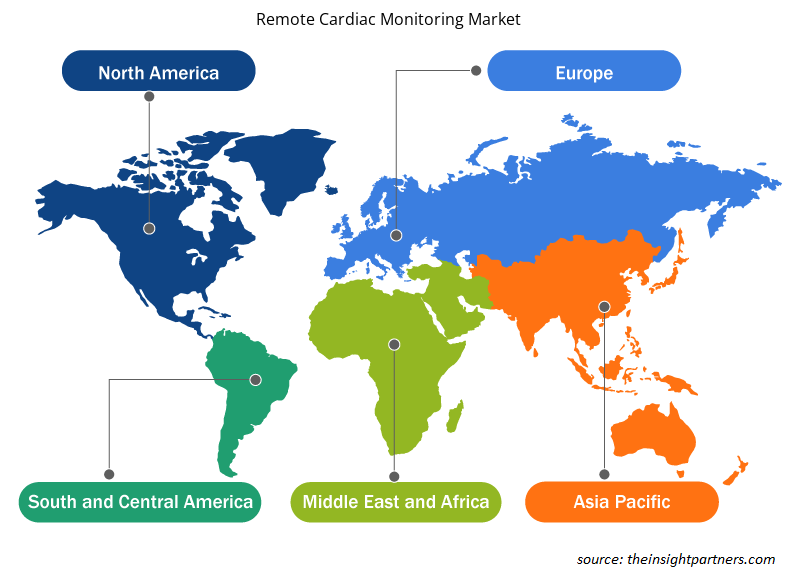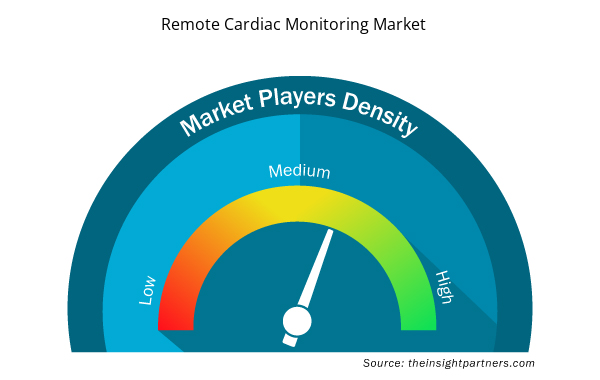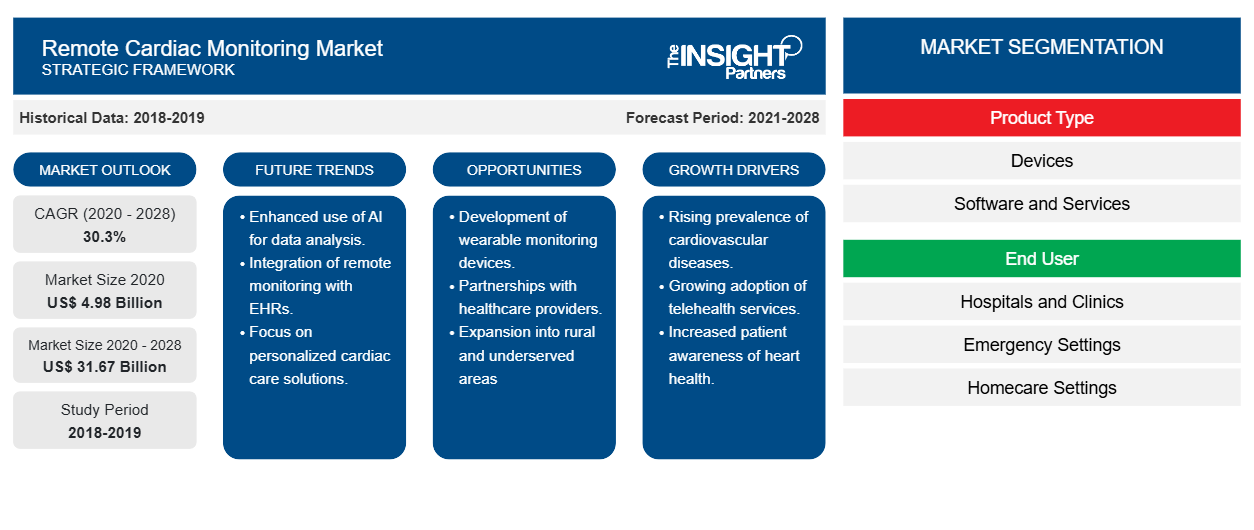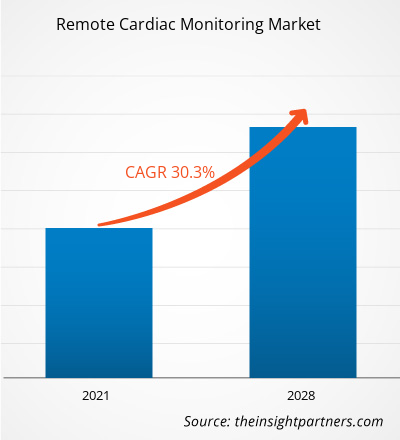Le marché de la surveillance cardiaque à distance devrait atteindre 31 671,69 millions USD d'ici 2028, contre 4 976,40 millions USD en 2021 ; il devrait croître à un TCAC de 30,3 % de 2021 à 2028.CAGR of 30.3% from 2021 to 2028.
Les dispositifs de surveillance cardiaque à distance permettent une surveillance continue des activités électriques du cœur en dehors des hôpitaux. Ils permettent également la surveillance électrocardiographique (ECG) à domicile des patients suspectés d'arythmies cardiaques ou présentant un risque de développer des arythmies. La surveillance peut également être effectuée lorsque les patients sont absorbés par leurs activités quotidiennes. Ainsi, l'un des avantages les plus importants de la surveillance cardiaque à distance est qu'elle réduit le besoin de visites de routine chez le médecin. Des dispositifs tels que des stimulateurs cardiaques et des défibrillateurs cardioverteurs implantables sont implantés dans le cœur des patients grâce à des procédures mini-invasives. Un émetteur qui fonctionne en synchronisation avec l'appareil assure la transmission des données. Des facteurs tels que l'augmentation de l'incidence des maladies cardiovasculaires (MCV) et les développements continus de l'approche de la télémédecine stimulent la croissance du marché de la surveillance cardiaque à distance . Cependant, les préoccupations concernant la confidentialité des données entravent la croissance du marché.
Personnalisez ce rapport en fonction de vos besoins
Vous bénéficierez d'une personnalisation gratuite de n'importe quel rapport, y compris de certaines parties de ce rapport, d'une analyse au niveau des pays, d'un pack de données Excel, ainsi que de superbes offres et réductions pour les start-ups et les universités.
- Obtenez les principales tendances clés du marché de ce rapport.Cet échantillon GRATUIT comprendra une analyse de données, allant des tendances du marché aux estimations et prévisions.
Informations sur le marché
Augmentation de l'incidence des maladies cardiovasculaires
La surveillance à distance des patients (RPM) permet aux patients de mieux gérer leur santé en augmentant leur implication dans leurs soins de santé. L'American Heart Association soutient les initiatives visant à encourager la conception et l'utilisation de technologies de surveillance à distance des patients fondées sur des données probantes. Selon l'Organisation mondiale de la santé (OMS), les maladies cardiovasculaires (MCV) sont parmi les principales causes de décès dans le monde et environ 30 millions de personnes subissent un accident vasculaire cérébral chaque année. Selon l'American Heart Association, près de la moitié des adultes aux États-Unis souffrent d'un type de MCV. En outre, plus de 130 millions de personnes, soit 45,1 % de la population américaine, devraient souffrir d'un type de MCV d'ici 2035. Selon les rapports de la Société européenne de cardiologie, les MCV causent 3,9 millions de décès en Europe et plus de 1,8 million de décès dans l'Union européenne (UE). De plus, elles représentent 45 % de tous les décès en Europe et 37 % du total des décès dans l'UE. Dans les pays de la région Asie-Pacifique, la mortalité due aux maladies cardiovasculaires varie de moins de 20 % dans des pays comme la Thaïlande, les Philippines et l’Indonésie à 20 à 30 % dans les zones urbaines de Chine, de Hong Kong, du Japon, de Corée et de Malaisie. En outre, la Nouvelle-Zélande, l’Australie et Singapour, entre autres, affichent des taux relativement élevés de 30 à 35 %.
L'hypertension est un facteur de risque important pour les maladies cardiovasculaires. La prévalence de l'hypertension ajustée selon l'âge chez les adultes aux États-Unis est d'environ 35 %, ce qui équivaut à une population d'environ 85 millions de personnes. D'ici 2035, environ 42 % des adultes du pays, soit 27 millions de plus, souffriront de cette maladie. Le fardeau financier de l'hypertension sur les économies est également en hausse, et les coûts devraient grimper d'environ 70 milliards de dollars américains en 2015 à environ 150 milliards de dollars américains d'ici 2035. La surveillance à distance des patients peut servir de moyen essentiel pour améliorer le contrôle de l'hypertension et réduire le fardeau économique découlant des séjours hospitaliers prolongés ou fréquents résultant d'événements liés à l'hypertension aiguë. Des recherches ont montré que la surveillance à distance des patients (RPM) peut réduire considérablement la pression artérielle systolique (PAS) et la pression artérielle diastolique (PAD) par rapport aux soins habituels et à l'autosurveillance seule. Selon quelques essais non randomisés, les dispositifs RPM peuvent améliorer les résultats en permettant une détection précise et précoce ainsi qu'en réduisant les taux de mortalité toutes causes confondues et les hospitalisations. Les directives cliniques récentes recommandent fortement l'utilisation du RPM pour la détection de la fibrillation auriculaire (FA) chez les patients victimes d'AVC et les patients non victimes d'AVC.
Informations basées sur le type de produit
En fonction du type de produit, le marché de la surveillance cardiaque à distance est encore segmenté en appareils, logiciels et services. Le segment des appareils détenait une part de marché plus importante en 2021 et devrait enregistrer un TCAC plus élevé au cours de la période de prévision.
Informations basées sur l'utilisateur final
En fonction de l'utilisateur final, le marché de la surveillance cardiaque à distance est segmenté en hôpitaux et cliniques, services d'urgence, services de soins à domicile et autres. Le segment des hôpitaux et cliniques détiendrait la plus grande part de marché en 2021, tandis que le marché du segment des services d'urgence devrait croître à un TCAC de 31,60 % au cours de la période de prévision.
Diverses entreprises opérant sur le marché de la surveillance cardiaque à distance adoptent des stratégies telles que les lancements de produits, les fusions et acquisitions, les collaborations, les innovations de produits et les extensions de portefeuille de produits pour étendre leur empreinte dans le monde entier, maintenir la marque et répondre à la demande croissante des utilisateurs finaux.
Aperçu régional du marché de la surveillance cardiaque à distance
Les tendances et facteurs régionaux influençant le marché de la surveillance cardiaque à distance tout au long de la période de prévision ont été expliqués en détail par les analystes d’Insight Partners. Cette section traite également des segments et de la géographie du marché de la surveillance cardiaque à distance en Amérique du Nord, en Europe, en Asie-Pacifique, au Moyen-Orient et en Afrique, ainsi qu’en Amérique du Sud et en Amérique centrale.

- Obtenez les données régionales spécifiques au marché de la surveillance cardiaque à distance
Portée du rapport sur le marché de la surveillance cardiaque à distance
| Attribut de rapport | Détails |
|---|---|
| Taille du marché en 2020 | 4,98 milliards de dollars américains |
| Taille du marché d'ici 2028 | 31,67 milliards de dollars américains |
| Taux de croissance annuel composé mondial (2020-2028) | 30,3% |
| Données historiques | 2018-2019 |
| Période de prévision | 2021-2028 |
| Segments couverts | Par type de produit
|
| Régions et pays couverts | Amérique du Nord
|
| Leaders du marché et profils d'entreprises clés |
|
Densité des acteurs du marché : comprendre son impact sur la dynamique des entreprises
Le marché de la surveillance cardiaque à distance connaît une croissance rapide, tirée par la demande croissante des utilisateurs finaux en raison de facteurs tels que l'évolution des préférences des consommateurs, les avancées technologiques et une plus grande sensibilisation aux avantages du produit. À mesure que la demande augmente, les entreprises élargissent leurs offres, innovent pour répondre aux besoins des consommateurs et capitalisent sur les tendances émergentes, ce qui alimente davantage la croissance du marché.
La densité des acteurs du marché fait référence à la répartition des entreprises ou des sociétés opérant sur un marché ou un secteur particulier. Elle indique le nombre de concurrents (acteurs du marché) présents sur un marché donné par rapport à sa taille ou à sa valeur marchande totale.
Les principales entreprises opérant sur le marché de la surveillance cardiaque à distance sont :
- Systèmes OSI, Inc.
- GE Santé
- Biotronik Se
- Société Nihon Kohden
- Laboratoires Abbott
Avis de non-responsabilité : les sociétés répertoriées ci-dessus ne sont pas classées dans un ordre particulier.

- Obtenez un aperçu des principaux acteurs du marché de la surveillance cardiaque à distance
Marché de la surveillance cardiaque à distance – par type de produit
- Appareils
- Logiciel
- Services
Marché de la surveillance cardiaque à distance – par utilisateur final
- Hôpitaux et cliniques
- Paramètres d'urgence
- Cadres de soins à domicile
- Autres
Marché de la surveillance cardiaque à distance – par géographie
- Amérique du Nord
- NOUS
- Canada
- Mexique
- Europe
- France
- Allemagne
- Italie
- ROYAUME-UNI
- Espagne
- Reste de l'Europe
- Asie-Pacifique (APAC)
- Chine
- Inde
- Corée du Sud
- Japon
- Australie
- Reste de l'Asie-Pacifique
- Moyen-Orient et Afrique (MEA)
- Afrique du Sud
- Arabie Saoudite
- Émirats arabes unis
- Reste du Moyen-Orient et de l'Afrique
- Amérique du Sud et Amérique centrale (SCAM)
- Brésil
- Argentine
- Reste de l'Amérique du Sud et de l'Amérique centrale
Profils d'entreprise
- Systèmes OSI, Inc.
- GE Santé
- Biotronik Se
- Société Nihon Kohden
- Laboratoires Abbott
- Société scientifique de Boston
- Royal Philips NV
- Honeywell International, Inc.
- AMC Santé
- Analyse historique (2 ans), année de base, prévision (7 ans) avec TCAC
- Analyse PEST et SWO
- Taille du marché Valeur / Volume - Mondial, Régional, Pays
- Industrie et paysage concurrentiel
- Ensemble de données Excel



Report Coverage
Revenue forecast, Company Analysis, Industry landscape, Growth factors, and Trends

Segment Covered
This text is related
to segments covered.

Regional Scope
North America, Europe, Asia Pacific, Middle East & Africa, South & Central America

Country Scope
This text is related
to country scope.
Questions fréquemment posées
Global remote cardiac monitoring market is segmented by region into North America, Europe, Asia Pacific, Middle East & Africa and South & Central America. In North America, the U.S. is the largest market for remote cardiac monitoring. The US is estimated to hold the largest share in the remote cardiac monitoring market during the forecast period. The growth of the market can be because of the rising investments in cardiology informatics, connected devices, and mobile solutions for advanced cardiac care, increasing product launches, and R&D activities to develop advanced remote cardiac monitoring devices. In addition, technologically advanced products are likely to stimulate the growth of remote cardiac monitoring market in North America. On the other hand, growing emphasis on cost optimization, focus on streamlining of clinical processes, increasing number of clinical trials, rise in the government initiatives, growing number of research and development activities, and rising number of product launches and approvals in the Asia Pacific is expected to account for the fastest growth of the region during the coming years.
The remote cardiac monitoring market majorly consists of the players such OSI Systems, Inc., GE Healthcare, Biotronik Se, Nihon Kohden Corporation, Abbott Laboratories, Boston Scientific Corporation, Koninklijke Philips N.V., Honeywell International, Inc. and AMC Health among others.
The hospitals and clinics segment dominated the global remote cardiac monitoring market and accounted for the largest revenue share of 37.60% in 2021.
The device segment dominated the global remote cardiac monitoring market and held the largest revenue share of 58.53% in 2021.
Remote cardiac monitoring is the constant monitoring of electrical activities of the heart, which practices place outside hospitals. The monitoring can also be performed while the patient is doing the day-to-day activities. Devices like pacemakers and implantable cardioverter-defibrillator are placed with the patient through minimally invasive procedures. The transmission of data takes place within a transmitter that works in sync with the device. Remote cardiac monitoring technologies allow home electrocardiographic (ECG) monitoring of patients with suspected cardiac arrhythmias or at risk for developing arrhythmias. One of the most important benefits of remote cardiac device monitoring is that it cuts down on routine doctor visits. Without remote monitoring, patients visited the doctor every three to six months (depending on device type) for a data download. With remote monitoring, the number of visits have dropped to one to two per year. Remote cardiac device monitoring is a fantastic way to follow patients and it has always been important, but it’s especially important in this era of COVID-19.
Key factors that are driving the growth of this market are increase in incidence of cardiovascular diseases, continuous developments in telemedicine approach, and rising investment in research and development are expected to boost the market growth for the remote cardiac monitoring over the years.
Trends and growth analysis reports related to Life Sciences : READ MORE..
The List of Companies - Remote Cardiac Monitoring Market
- OSI Systems, Inc.
- GE Healthcare
- Biotronik Se
- Nihon Kohden Corporation
- Abbott Laboratories
- Boston Scientific Corporation
- Koninklijke Philips N.V.
- Honeywell International, Inc.
- AMC Health
The Insight Partners performs research in 4 major stages: Data Collection & Secondary Research, Primary Research, Data Analysis and Data Triangulation & Final Review.
- Data Collection and Secondary Research:
As a market research and consulting firm operating from a decade, we have published and advised several client across the globe. First step for any study will start with an assessment of currently available data and insights from existing reports. Further, historical and current market information is collected from Investor Presentations, Annual Reports, SEC Filings, etc., and other information related to company’s performance and market positioning are gathered from Paid Databases (Factiva, Hoovers, and Reuters) and various other publications available in public domain.
Several associations trade associates, technical forums, institutes, societies and organization are accessed to gain technical as well as market related insights through their publications such as research papers, blogs and press releases related to the studies are referred to get cues about the market. Further, white papers, journals, magazines, and other news articles published in last 3 years are scrutinized and analyzed to understand the current market trends.
- Primary Research:
The primarily interview analysis comprise of data obtained from industry participants interview and answers to survey questions gathered by in-house primary team.
For primary research, interviews are conducted with industry experts/CEOs/Marketing Managers/VPs/Subject Matter Experts from both demand and supply side to get a 360-degree view of the market. The primary team conducts several interviews based on the complexity of the markets to understand the various market trends and dynamics which makes research more credible and precise.
A typical research interview fulfils the following functions:
- Provides first-hand information on the market size, market trends, growth trends, competitive landscape, and outlook
- Validates and strengthens in-house secondary research findings
- Develops the analysis team’s expertise and market understanding
Primary research involves email interactions and telephone interviews for each market, category, segment, and sub-segment across geographies. The participants who typically take part in such a process include, but are not limited to:
- Industry participants: VPs, business development managers, market intelligence managers and national sales managers
- Outside experts: Valuation experts, research analysts and key opinion leaders specializing in the electronics and semiconductor industry.
Below is the breakup of our primary respondents by company, designation, and region:

Once we receive the confirmation from primary research sources or primary respondents, we finalize the base year market estimation and forecast the data as per the macroeconomic and microeconomic factors assessed during data collection.
- Data Analysis:
Once data is validated through both secondary as well as primary respondents, we finalize the market estimations by hypothesis formulation and factor analysis at regional and country level.
- Macro-Economic Factor Analysis:
We analyse macroeconomic indicators such the gross domestic product (GDP), increase in the demand for goods and services across industries, technological advancement, regional economic growth, governmental policies, the influence of COVID-19, PEST analysis, and other aspects. This analysis aids in setting benchmarks for various nations/regions and approximating market splits. Additionally, the general trend of the aforementioned components aid in determining the market's development possibilities.
- Country Level Data:
Various factors that are especially aligned to the country are taken into account to determine the market size for a certain area and country, including the presence of vendors, such as headquarters and offices, the country's GDP, demand patterns, and industry growth. To comprehend the market dynamics for the nation, a number of growth variables, inhibitors, application areas, and current market trends are researched. The aforementioned elements aid in determining the country's overall market's growth potential.
- Company Profile:
The “Table of Contents” is formulated by listing and analyzing more than 25 - 30 companies operating in the market ecosystem across geographies. However, we profile only 10 companies as a standard practice in our syndicate reports. These 10 companies comprise leading, emerging, and regional players. Nonetheless, our analysis is not restricted to the 10 listed companies, we also analyze other companies present in the market to develop a holistic view and understand the prevailing trends. The “Company Profiles” section in the report covers key facts, business description, products & services, financial information, SWOT analysis, and key developments. The financial information presented is extracted from the annual reports and official documents of the publicly listed companies. Upon collecting the information for the sections of respective companies, we verify them via various primary sources and then compile the data in respective company profiles. The company level information helps us in deriving the base number as well as in forecasting the market size.
- Developing Base Number:
Aggregation of sales statistics (2020-2022) and macro-economic factor, and other secondary and primary research insights are utilized to arrive at base number and related market shares for 2022. The data gaps are identified in this step and relevant market data is analyzed, collected from paid primary interviews or databases. On finalizing the base year market size, forecasts are developed on the basis of macro-economic, industry and market growth factors and company level analysis.
- Data Triangulation and Final Review:
The market findings and base year market size calculations are validated from supply as well as demand side. Demand side validations are based on macro-economic factor analysis and benchmarks for respective regions and countries. In case of supply side validations, revenues of major companies are estimated (in case not available) based on industry benchmark, approximate number of employees, product portfolio, and primary interviews revenues are gathered. Further revenue from target product/service segment is assessed to avoid overshooting of market statistics. In case of heavy deviations between supply and demand side values, all thes steps are repeated to achieve synchronization.
We follow an iterative model, wherein we share our research findings with Subject Matter Experts (SME’s) and Key Opinion Leaders (KOLs) until consensus view of the market is not formulated – this model negates any drastic deviation in the opinions of experts. Only validated and universally acceptable research findings are quoted in our reports.
We have important check points that we use to validate our research findings – which we call – data triangulation, where we validate the information, we generate from secondary sources with primary interviews and then we re-validate with our internal data bases and Subject matter experts. This comprehensive model enables us to deliver high quality, reliable data in shortest possible time.


 Obtenez un échantillon gratuit pour ce rapport
Obtenez un échantillon gratuit pour ce rapport